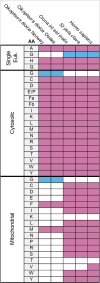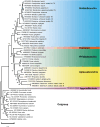Evolutionary Insights from the Mitochondrial Genome of Oikopleura dioica: Sequencing Challenges, RNA Editing, Gene Transfers to the Nucleus, and tRNA Loss
- PMID: 39162337
- PMCID: PMC11384887
- DOI: 10.1093/gbe/evae181
Evolutionary Insights from the Mitochondrial Genome of Oikopleura dioica: Sequencing Challenges, RNA Editing, Gene Transfers to the Nucleus, and tRNA Loss
Abstract
Sequencing the mitochondrial genome of the tunicate Oikopleura dioica is a challenging task due to the presence of long poly-A/T homopolymer stretches, which impair sequencing and assembly. Here, we report on the sequencing and annotation of the majority of the mitochondrial genome of O. dioica by means of combining several DNA and amplicon reads obtained by Illumina and MinIon Oxford Nanopore Technologies with public RNA sequences. We document extensive RNA editing, since all homopolymer stretches present in the mitochondrial DNA correspond to 6U-regions in the mitochondrial RNA. Out of the 13 canonical protein-coding genes, we were able to detect eight, plus an unassigned open reading frame that lacked sequence similarity to canonical mitochondrial protein-coding genes. We show that the nad3 gene has been transferred to the nucleus and acquired a mitochondria-targeting signal. In addition to two very short rRNAs, we could only identify a single tRNA (tRNA-Met), suggesting multiple losses of tRNA genes, supported by a corresponding loss of mitochondrial aminoacyl-tRNA synthetases in the nuclear genome. Based on the eight canonical protein-coding genes identified, we reconstructed maximum likelihood and Bayesian phylogenetic trees and inferred an extreme evolutionary rate of this mitochondrial genome. The phylogenetic position of appendicularians among tunicates, however, could not be accurately determined.
Keywords: Appendicularia; Oxford Nanopore Technologies; Tunicata; mtDNA; phylogenomics; poly-A/T homopolymers.
© The Author(s) 2024. Published by Oxford University Press on behalf of Society for Molecular Biology and Evolution.
Figures




Similar articles
-
Tracing Homopolymers in Oikopleura dioica's Mitogenome.Genome Biol Evol. 2024 Sep 3;16(9):evae182. doi: 10.1093/gbe/evae182. Genome Biol Evol. 2024. PMID: 39162185 Free PMC article.
-
Tunicate mitogenomics and phylogenetics: peculiarities of the Herdmania momus mitochondrial genome and support for the new chordate phylogeny.BMC Genomics. 2009 Nov 17;10:534. doi: 10.1186/1471-2164-10-534. BMC Genomics. 2009. PMID: 19922605 Free PMC article.
-
Mitochondrial analysis of oribatid mites provides insights into their atypical tRNA annotation, genome rearrangement and evolution.Parasit Vectors. 2021 Apr 23;14(1):221. doi: 10.1186/s13071-021-04719-0. Parasit Vectors. 2021. PMID: 33892790 Free PMC article.
-
Evolution of eukaryotic genome architecture: Insights from the study of a rapidly evolving metazoan, Oikopleura dioica: Non-adaptive forces such as elevated mutation rates may influence the evolution of genome architecture.Bioessays. 2011 Aug;33(8):592-601. doi: 10.1002/bies.201100034. Epub 2011 Jun 17. Bioessays. 2011. PMID: 21681984 Review.
-
Oikopleura dioica: An Emergent Chordate Model to Study the Impact of Gene Loss on the Evolution of the Mechanisms of Development.Results Probl Cell Differ. 2019;68:63-105. doi: 10.1007/978-3-030-23459-1_4. Results Probl Cell Differ. 2019. PMID: 31598853 Review.
Cited by
-
Know your limits; miniCOI metabarcoding fails with key marine zooplankton taxa.J Plankton Res. 2024 Nov 2;46(6):581-595. doi: 10.1093/plankt/fbae057. eCollection 2024 Nov-Dec. J Plankton Res. 2024. PMID: 39664260 Free PMC article. Review.
-
The complete mitogenome of an unidentified Oikopleura species.F1000Res. 2025 Mar 7;13:1357. doi: 10.12688/f1000research.157311.2. eCollection 2024. F1000Res. 2025. PMID: 40248647 Free PMC article.
-
Tracing Homopolymers in Oikopleura dioica's Mitogenome.Genome Biol Evol. 2024 Sep 3;16(9):evae182. doi: 10.1093/gbe/evae182. Genome Biol Evol. 2024. PMID: 39162185 Free PMC article.
References
-
- Ari Ş, Arikan M. Next-generation sequencing: advantages, disadvantages, and future. In: Hakeem KR, Tombuloğlu H, Tombuloğlu G, editors. Plant omics: trends and applications. Cham: Springer International Publishing; 2016. p. 109–135.
MeSH terms
Substances
Grants and funding
LinkOut - more resources
Full Text Sources
Miscellaneous

